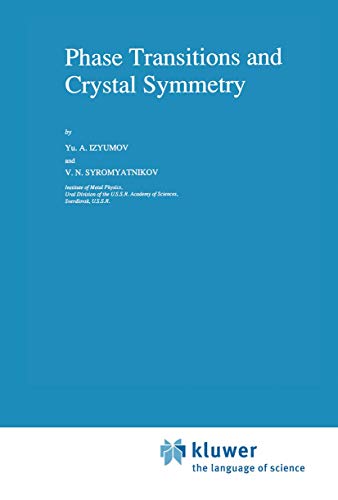Articoli correlati a Phase Transitions and Crystal Symmetry: 38

Le informazioni nella sezione "Riassunto" possono far riferimento a edizioni diverse di questo titolo.
Le informazioni nella sezione "Su questo libro" possono far riferimento a edizioni diverse di questo titolo.
- EditoreKluwer Academic Pub
- Data di pubblicazione1990
- ISBN 10 0792305426
- ISBN 13 9780792305422
- RilegaturaCopertina rigida
- Numero di pagine468
Compra nuovo
Scopri di più su questo articolo
Spese di spedizione:
GRATIS
In U.S.A.
I migliori risultati di ricerca su AbeBooks
Phase Transitions and Crystal Symmetry (Fundamental Theories of Physics) by Izyumov, Yurii Aleksandrovich, Syromyatnikov, V.N. [Hardcover ]
Descrizione libro Hardcover. Condizione: new. Codice articolo 9780792305422
Phase Transitions and Crystal Symmetry
Descrizione libro Gebunden. Condizione: New. Codice articolo 5965883
Phase Transitions and Crystal Symmetry
Print on DemandDescrizione libro Condizione: New. PRINT ON DEMAND Book; New; Fast Shipping from the UK. No. book. Codice articolo ria9780792305422_lsuk
Phase Transitions and Crystal Symmetry (Fundamental Theories of Physics, 38)
Descrizione libro Condizione: New. Codice articolo ABLIING23Feb2416190180462
Phase Transitions and Crystal Symmetry
Descrizione libro Buch. Condizione: Neu. This item is printed on demand - it takes 3-4 days longer - Neuware -About half a century ago Landau formulated the central principles of the phe nomenological second-order phase transition theory which is based on the idea of spontaneous symmetry breaking at phase transition. By means of this ap proach it has been possible to treat phase transitions of different nature in altogether distinct systems from a unified viewpoint, to embrace the aforemen tioned transitions by a unified body of mathematics and to show that, in a certain sense, physical systems in the vicinity of second-order phase transitions exhibit universal behavior. For several decades the Landau method has been extensively used to an alyze specific phase transitions in systems and has been providing a basis for interpreting experimental data on the behavior of physical characteristics near the phase transition, including the behavior of these characteristics in systems subject to various external effects such as pressure, electric and magnetic fields, deformation, etc. The symmetry aspects of Landau's theory are perhaps most effective in analyzing phase transitions in crystals because the relevant body of mathemat ics for this symmetry, namely, the crystal space group representation, has been worked out in great detail. Since particular phase transitions in crystals often call for a subtle symmetry analysis, the Landau method has been continually refined and developed over the past ten or fifteen years. 468 pp. Englisch. Codice articolo 9780792305422
Phase Transitions and Crystal Symmetry
Descrizione libro Buch. Condizione: Neu. Druck auf Anfrage Neuware - Printed after ordering - About half a century ago Landau formulated the central principles of the phe nomenological second-order phase transition theory which is based on the idea of spontaneous symmetry breaking at phase transition. By means of this ap proach it has been possible to treat phase transitions of different nature in altogether distinct systems from a unified viewpoint, to embrace the aforemen tioned transitions by a unified body of mathematics and to show that, in a certain sense, physical systems in the vicinity of second-order phase transitions exhibit universal behavior. For several decades the Landau method has been extensively used to an alyze specific phase transitions in systems and has been providing a basis for interpreting experimental data on the behavior of physical characteristics near the phase transition, including the behavior of these characteristics in systems subject to various external effects such as pressure, electric and magnetic fields, deformation, etc. The symmetry aspects of Landau's theory are perhaps most effective in analyzing phase transitions in crystals because the relevant body of mathemat ics for this symmetry, namely, the crystal space group representation, has been worked out in great detail. Since particular phase transitions in crystals often call for a subtle symmetry analysis, the Landau method has been continually refined and developed over the past ten or fifteen years. Codice articolo 9780792305422

